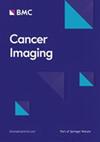FDG PET/CT 成像特征与结直肠癌肿瘤免疫微环境和预后的关系:一项回顾性研究
IF 3.5
2区 医学
Q2 ONCOLOGY
引用次数: 0
摘要
结直肠癌在 2-脱氧-2-[18F]氟-d-葡萄糖(FDG)正电子发射断层扫描/计算机断层扫描(PET/CT)上的成像特征被认为受肿瘤特征和肿瘤免疫微环境的影响。然而,PET/CT成像特征与肿瘤组织中免疫反应之间的关系尚未得到全面评估。本研究探讨了肿瘤、骨髓和脾脏中的 FDG PET/CT 成像特征与肿瘤组织免疫组化结果和结直肠癌患者无复发生存期(RFS)之间的关系。研究人员回顾性研究了119名接受FDG PET/CT分期检查并接受根治性手术切除的结直肠癌患者。通过 PET/CT 图像,测量了原发性肿瘤的 10 个一阶成像特征,包括 FDG 摄取强度、体积代谢参数和代谢异质性参数,以及骨髓和脾脏的 FDG 摄取情况。通过对手术标本进行免疫组化分析,对 CD4+、CD8+和 CD163 + 细胞浸润程度以及白细胞介素-6(IL-6)和基质金属蛋白酶-11(MMP-11)的表达进行分级。评估了 FDG PET/CT 成像特征与免疫组化结果之间的关系,并评估了 PET/CT 成像特征在预测 RFS 方面的预后意义。与免疫组化结果的相关性分析表明,CD4 +和CD163 +细胞浸润程度以及IL-6和MMP-11的表达与PET/CT上的癌症成像特征相关。癌症组织中炎症反应增强的患者表现出更高的 FDG 摄取、体积代谢参数和代谢异质性。骨髓和脾脏的 FDG 摄取分别与 CD163 + 细胞浸润程度和 IL-6 表达呈正相关。在多变量生存分析中,肿瘤的FDG摄取变异系数(p = 0.019;增加0.10,危险比为0.484)和脾脏与肝脏摄取比(p = 0.020;增加1.0,危险比为24.901)是RFS的重要独立预测因子。肿瘤的代谢异质性和脾脏的FDG摄取与肿瘤免疫微环境相关,在预测结直肠癌患者的RFS方面具有预后意义。本文章由计算机程序翻译,如有差异,请以英文原文为准。
Relationship of FDG PET/CT imaging features with tumor immune microenvironment and prognosis in colorectal cancer: a retrospective study
Imaging features of colorectal cancers on 2-deoxy-2-[18F]fluoro-d-glucose (FDG) positron emission tomography/computed tomography (PET/CT) have been considered to be affected by tumor characteristics and tumor immune microenvironment. However, the relationship between PET/CT imaging features and immune reactions in tumor tissue has not yet been fully evaluated. This study investigated the association of FDG PET/CT imaging features in the tumor, bone marrow, and spleen with immunohistochemical results of cancer tissue and recurrence-free survival (RFS) in patients with colorectal cancer. A total of 119 patients with colorectal cancer who underwent FDG PET/CT for staging work-up and received curative surgical resection were retrospectively enrolled. From PET/CT images, 10 first-order imaging features of primary tumors, including intensity of FDG uptake, volumetric metabolic parameters, and metabolic heterogeneity parameters, as well as FDG uptake in the bone marrow and spleen were measured. The degrees of CD4+, CD8+, and CD163 + cell infiltration and interleukin-6 (IL-6) and matrix metalloproteinase-11 (MMP-11) expression were graded through immunohistochemical analysis of surgical specimens. The relationship between FDG PET/CT imaging features and immunohistochemical results was assessed, and prognostic significance of PET/CT imaging features in predicting RFS was evaluated. Correlation analysis with immunohistochemistry findings showed that the degrees of CD4 + and CD163 + cell infiltration and IL-6 and MMP-11 expression were correlated with cancer imaging features on PET/CT. Patients with enhanced inflammatory response in cancer tissue demonstrated increased FDG uptake, volumetric metabolic parameters, and metabolic heterogeneity. FDG uptake in the bone marrow and spleen was positively correlated with the degree of CD163 + cell infiltration and IL-6 expression, respectively. In multivariate survival analysis, the coefficient of variation of FDG uptake in the tumor (p = 0.019; hazard ratio, 0.484 for 0.10 increase) and spleen-to-liver uptake ratio (p = 0.020; hazard ratio, 24.901 for 1.0 increase) were significant independent predictors of RFS. The metabolic heterogeneity of tumors and FDG uptake in the spleen were correlated with tumor immune microenvironment and showed prognostic significance in predicting RFS in patients with colorectal cancer.
求助全文
通过发布文献求助,成功后即可免费获取论文全文。
去求助
来源期刊

Cancer Imaging
ONCOLOGY-RADIOLOGY, NUCLEAR MEDICINE & MEDICAL IMAGING
CiteScore
7.00
自引率
0.00%
发文量
66
审稿时长
>12 weeks
期刊介绍:
Cancer Imaging is an open access, peer-reviewed journal publishing original articles, reviews and editorials written by expert international radiologists working in oncology.
The journal encompasses CT, MR, PET, ultrasound, radionuclide and multimodal imaging in all kinds of malignant tumours, plus new developments, techniques and innovations. Topics of interest include:
Breast Imaging
Chest
Complications of treatment
Ear, Nose & Throat
Gastrointestinal
Hepatobiliary & Pancreatic
Imaging biomarkers
Interventional
Lymphoma
Measurement of tumour response
Molecular functional imaging
Musculoskeletal
Neuro oncology
Nuclear Medicine
Paediatric.
 求助内容:
求助内容: 应助结果提醒方式:
应助结果提醒方式:


